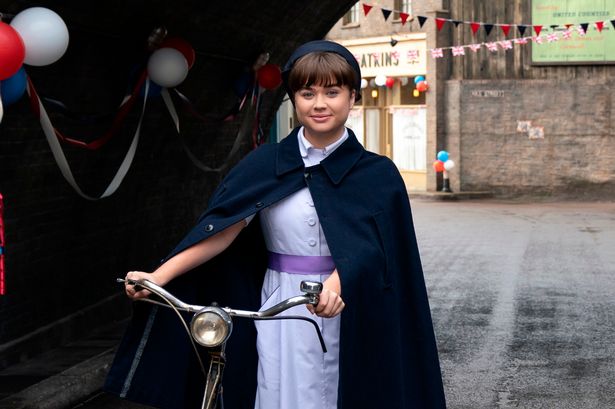“Call the Midwife” is back, with a gentle journey through history – human history, medical history, even fashion history.
Yes, fashions. This series (8 p.m. Sundays, PBS) was set in 1957, then advanced one year each season. The new season (starting Oct. 3) is in 1966 – the Beatles era, when London’s “Carnaby Street” look was starting to catch on.
That’s especially clear in the fourth episode (Oct. 24), when young actress Megan Cusack arrives, playing a nursing student. She’s shown here in her uniform, but at dinner, she surprises others – including the nuns — with her flashy dress.
“It truly does feel like a costume,” Cusack told the Television Critics Association. “When you put it on, you are getting into that era and that vibe and the fact that she likes to stand out.”
For Cusack, this is ancient history; 1966 was 30 years before she was born. But Jenny Agutter, one of the “Midwife” stars, remembers the year well. She was entering her teens then, amid a look that was popularized by designer Mary Quant, model Twiggy and others.
“I had a ‘Quant skirt,’ which was a mini-skirt, and hot pants and all the rest of it,” she said. “So that world was very different for me than the one I’m playing in.”
She plays Sister Julienne, leading a financially strapped effort to provide childbirth services to people in London’s hard-scrabble East End. Her role is a long way from hot pants.
“I have never entirely understood Sister Julienne,” Agutter said, “because she’s so far from (me. But) I understand about her faith; I understand about her dedication.”
The series is based on memoirs by Jennifer Worth, an East End midwife in the 1950s. “There was never any expectation that there be a second” season, said writer-producer Heidi Thomas.
But ratings soared in England and the series was soon going far beyond Worth’s midwife years.
The year 1957 may have been an ideal time to start “Midwife,” actor Stephen McGann said. The National Health Service was less than a decade old, in “the austerity aftermath of the Second World War”; still, it “was up and running like crazy, because it was full of zeal.”
McGann has multiple perspectives here: In real life, he’s married to Thomas; on the show, he’s Dr. Patrick Turner. And, with a college degree in science communication, he’s given talks and written books about medical history.
In the ‘50s, he said, the NHS “had fantastic new weapons in antibiotics” and vaccinations. Facing fierce diseases, “health was beginning to win.”
At the time, many of the British births were still at home, done by midwives; by 1970, one source says, 80 percent were in hospitals. “Midwife,” McGann said, shows the gradual “almost industrialization of the processes of childbirth.”
But in ‘66, it was still very personal. In her first episode, Cusack delivers a difficult birth alone.
Some characters have been able to settle slowly into the action. Ella Bruccoleri, who plays the cherub-faced Sister Frances, recalls a “gentle easing into the show …. If that had been something really intense, I would have totally messed it up and ruined my career.”
Cusack had no such grace period. Two days after she sent her audition tape, she got the part.
Yes, she’s related to key people. Her grandfather (Cyril Cusack) was an acclaimed actor; so is her aunt (Sinead Cusack), who is married to Oscar-winner Jeremy Irons. But her own background is limited.
“When I moved to London, I didn’t have a TV,” Cusack said. “And in Ireland, we only had a 12-inch that didn’t get many channels. And when the tide was high, the TV really didn’t work.”
Starting work, she said, her reaction was: “Oh, goodness gracious, there’s quite a few people here.”
Soon, those people would immerse her in ‘60s-style fashion and medicine.
